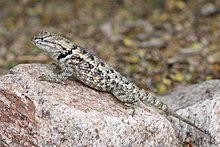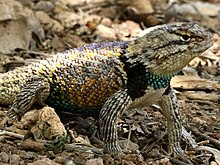316:
sexes have brownish/yellow triangular spots on their shoulders. A female desert spiny lizard will lay anywhere from 4 to 24 eggs during the summertime. A fully grown desert spiny lizard will reach a body length of up to 5.6 inches. Besides their bright colors, the desert spiny lizard changes to darker colors during the winter to allow them to absorb more heat from the sunshine, and become lighter during the summer to reflect the Sun's radiation. It is frequently seen doing push-ups, pushing its body up and down, as a form of territorial display. The first recorded case of
Leukemia in the family Phrynosomatidae was found in this species.
51:
100:
345:
42:
75:
757:"Desert Spiny Lizard." Arizona-Sonora Desert Museum. Craig Ivanyi. Web.23 Mar. 2015 "Lizards." Reptiles & Amphibians Of The West (1974): 28. Science Reference Center. Web. 23 Mar. 2015. Brennan, Thomas C. "Desert Spiny Lizard (Sceloporus Magister) - Reptiles of Arizona." Desert Spiny Lizard (Sceloporus Magister) - Reptiles of Arizona. N.p., 2008. Web. 13 May 2015.
332:
Like many desert lizards, desert spiny lizards adjust their internal temperature by changing color so they are darker during cool times, which allows them to absorb more heat from the sun, and become lighter during warm times so they reflect more solar radiation. The desert spiny lizard also uses
315:
An adult male desert spiny lizard usually have conspicuous blue/violet patches on the belly and throat, and a green/blue color on their tails and sides. Females and juveniles have large combined dark spots on their back and belly areas, and the blue/violet and green/blue coloring is absent. Both
340:
Usually, during the morning hours, it will be out basking in the sun on rocks or any hard surface that is in direct sunlight, but like many desert reptiles, it will seek shelter, usually underground in burrows or any suitable cover that provides shade, during the hottest part of the day in the
361:, and woodlands are home to this lizard. It is usually encountered on lower slopes, bajadas, plains, and low valleys, often in the branches of trees or in the vicinity of ground cover such as wood piles, rock piles, and
324:
The desert spiny lizard ranges across the deserts of southern
Arizona and the northeastern plateaus at elevations ranging from near sea level along the Colorado River to about 5,000 feet.
1059:
996:
341:
summertime, as shade provides cooler temperatures than on the ground's surface. It hibernates in late fall and during the cold months of winter before re-emerging in spring.
643:"A genetic perspective on the geographic association of taxa among arid North American lizards of the Sceloporus magister complex (Squamata: Iguanidae: Phrynosomatinae)"
1054:
900:
952:
1029:
373:
The desert spiny lizard feeds on a variety of insects including ants, beetles, and caterpillars. It also feeds on spiders, centipedes, and small lizards.
874:
913:
775:
642:
1044:
1049:
1064:
497:
698:
416:
220:
918:
767:
365:
nests. The desert spiny lizard is a primarily arboreal species that prefer cottonwood, yucca, Joshua trees, and ironwood.
527:
1039:
99:
731:
957:
449:
470:, when genetic analysis revealed that it is sufficiently distinct to merit classification as its own species.
826:
788:
357:
Biotic communities including
Sonoran Desertscrub, Great Basin Desertscrub, Semidesert Grassland, Interior
440:
204:
861:
835:
657:
465:
614:
Parker, W.S; Pianka, E.R (1973). "Notes on the
Ecology of the Iguanid Lizard, Sceloporus magister".
1034:
944:
64:
50:
681:
623:
596:
94:
905:
978:
848:
673:
588:
580:
436:
344:
296:
248:
41:
1006:
991:
983:
840:
743:
727:
665:
570:
405:
931:
965:
292:
244:
171:
661:
252:
714:
Phelan, R.L.; Brattstrom, B.H. (1955). "Geographic variation in
Sceloporus magister".
1023:
926:
488:
454:
84:
79:
685:
600:
853:
181:
161:
17:
939:
887:
820:
669:
575:
558:
382:
334:
276:
268:
811:
584:
358:
111:
748:
677:
970:
592:
805:
362:
300:
151:
131:
533:
879:
627:
444:
304:
264:
141:
892:
559:"A Case of Leukemia in the Desert Spiny Lizard (Sceloporus magister)"
288:
280:
240:
121:
782:
641:
Schulte, James A.; Macey, J. Robert; Papenfuss, Theodore J. (2006).
272:
284:
866:
786:
487:
Hammerson, G.A.; Frost, D.R.; Santos-Barrera, G. (2007).
701:(1854). "Description of new reptiles from California".
348:
Vivid ventral coloring of a male desert spiny lizard
795:
557:Goldberg, Stephen R.; Holshuh, H. J. (July 1991).
263:In the United States it is found in the states of
389:, including the nominate race, are recognized.
1060:Taxa named by Edward Hallowell (herpetologist)
732:"A new Sceloporus magister from eastern Utah"
8:
287:. It is also found in the Mexican states of
783:
337:so it is not so easily seen by predators.
73:
49:
40:
31:
747:
574:
463:was elevated to species status in 2006 (
343:
1055:Fauna of the Southwestern United States
776:Integrated Taxonomic Information System
515:Dahms Tierleben. www.dahmstierleben.de.
479:
547:"Lizards" 28. Science Reference Center
543:
541:
650:Molecular Phylogenetics and Evolution
523:
521:
7:
1030:IUCN Red List least concern species
498:IUCN Red List of Threatened Species
433:Sceloporus magister monserratensis
25:
98:
58:Female (above) and male (below)
1:
1045:Reptiles of the United States
534:Reptarium.cz Reptile Database
461:Sceloporus magister uniformis
427:Phelan & Brattstrom, 1955
397:Phelan & Brattstrom, 1955
563:Journal of Wildlife Diseases
1050:Fauna of the Sonoran Desert
703:Proc. Acad. Nat. Sci. Phila
670:10.1016/j.ympev.2005.04.033
1081:
1065:Reptiles described in 1854
576:10.7589/0090-3558-27.3.521
443:, 1921) was elevated to a
457:Ernest A. Liner in 1994.
450:Sceloporus monserratensis
210:
203:
95:Scientific classification
93:
71:
62:
57:
48:
39:
34:
749:10.5962/bhl.part.14056
736:Great Basin Naturalist
349:
243:species of the family
347:
505:: e.T64123A12746824.
466:Sceloporus uniformis
235:, also known as the
35:Desert spiny lizard
841:Sceloporus_magister
827:Sceloporus magister
797:Sceloporus magister
770:Sceloporus magister
662:2006MolPE..39..873S
529:Sceloporus magister
491:Sceloporus magister
402:S. m. cephaloflavus
387:Sceloporus magister
237:desert spiny lizard
232:Sceloporus magister
214:Sceloporus magister
65:Conservation status
18:Desert spiny lizard
1040:Reptiles of Mexico
350:
255:of North America.
1017:
1016:
979:Open Tree of Life
789:Taxon identifiers
428:
424:S. m. transversus
420:
409:
398:
394:S. m. bimaculosus
249:Chihuahuan Desert
247:, native to the
228:
227:
88:
27:Species of lizard
16:(Redirected from
1072:
1010:
1009:
1000:
999:
987:
986:
974:
973:
961:
960:
948:
947:
935:
934:
922:
921:
909:
908:
896:
895:
883:
882:
870:
869:
857:
856:
844:
843:
831:
830:
829:
816:
815:
814:
784:
779:
753:
751:
723:
710:
690:
689:
647:
638:
632:
631:
611:
605:
604:
578:
554:
548:
545:
536:
525:
516:
513:
507:
506:
484:
426:
415:
404:
396:
259:Geographic range
216:
196:S. magister
103:
102:
82:
77:
76:
53:
44:
32:
21:
1080:
1079:
1075:
1074:
1073:
1071:
1070:
1069:
1020:
1019:
1018:
1013:
1005:
1003:
995:
990:
982:
977:
969:
966:Observation.org
964:
956:
951:
943:
938:
930:
925:
917:
912:
904:
899:
891:
886:
878:
873:
865:
860:
852:
847:
839:
834:
825:
824:
819:
810:
809:
804:
791:
766:
763:
726:
713:
697:
694:
693:
645:
640:
639:
635:
613:
612:
608:
556:
555:
551:
546:
539:
526:
519:
514:
510:
486:
485:
481:
476:
379:
371:
355:
330:
322:
313:
293:Baja California
261:
245:Phrynosomatidae
224:
218:
212:
199:
172:Phrynosomatidae
97:
89:
78:
74:
67:
28:
23:
22:
15:
12:
11:
5:
1078:
1076:
1068:
1067:
1062:
1057:
1052:
1047:
1042:
1037:
1032:
1022:
1021:
1015:
1014:
1012:
1011:
1001:
988:
975:
962:
949:
936:
923:
910:
897:
884:
871:
858:
845:
832:
817:
801:
799:
793:
792:
787:
781:
780:
762:
761:External links
759:
755:
754:
724:
711:
692:
691:
656:(3): 873–880.
633:
622:(2): 143–152.
606:
569:(3): 521–525.
549:
537:
517:
508:
478:
477:
475:
472:
430:
429:
421:
413:S. m. magister
410:
399:
378:
375:
370:
367:
354:
351:
329:
326:
321:
318:
312:
309:
260:
257:
253:Sonoran Desert
226:
225:
219:
208:
207:
201:
200:
193:
191:
187:
186:
179:
175:
174:
169:
165:
164:
159:
155:
154:
149:
145:
144:
139:
135:
134:
129:
125:
124:
119:
115:
114:
109:
105:
104:
91:
90:
72:
69:
68:
63:
60:
59:
55:
54:
46:
45:
37:
36:
26:
24:
14:
13:
10:
9:
6:
4:
3:
2:
1077:
1066:
1063:
1061:
1058:
1056:
1053:
1051:
1048:
1046:
1043:
1041:
1038:
1036:
1033:
1031:
1028:
1027:
1025:
1008:
1002:
998:
993:
989:
985:
980:
976:
972:
967:
963:
959:
954:
950:
946:
941:
937:
933:
928:
924:
920:
915:
911:
907:
902:
898:
894:
889:
885:
881:
876:
872:
868:
863:
859:
855:
850:
846:
842:
837:
833:
828:
822:
818:
813:
807:
803:
802:
800:
798:
794:
790:
785:
777:
773:
771:
765:
764:
760:
758:
750:
745:
741:
737:
733:
729:
725:
721:
717:
716:Herpetologica
712:
708:
704:
700:
699:Hallowell, E.
696:
695:
687:
683:
679:
675:
671:
667:
663:
659:
655:
651:
644:
637:
634:
629:
625:
621:
617:
616:Herpetologica
610:
607:
602:
598:
594:
590:
586:
582:
577:
572:
568:
564:
560:
553:
550:
544:
542:
538:
535:
531:
530:
524:
522:
518:
512:
509:
504:
500:
499:
494:
492:
483:
480:
473:
471:
469:
467:
462:
458:
456:
455:herpetologist
452:
451:
446:
442:
438:
434:
425:
422:
418:
414:
411:
407:
403:
400:
395:
392:
391:
390:
388:
384:
376:
374:
368:
366:
364:
360:
352:
346:
342:
338:
336:
327:
325:
319:
317:
310:
308:
306:
302:
298:
294:
290:
286:
282:
278:
274:
270:
266:
258:
256:
254:
250:
246:
242:
238:
234:
233:
222:
217:
215:
209:
206:
205:Binomial name
202:
198:
197:
192:
189:
188:
185:
184:
180:
177:
176:
173:
170:
167:
166:
163:
160:
157:
156:
153:
150:
147:
146:
143:
140:
137:
136:
133:
130:
127:
126:
123:
120:
117:
116:
113:
110:
107:
106:
101:
96:
92:
86:
81:
80:Least Concern
70:
66:
61:
56:
52:
47:
43:
38:
33:
30:
19:
796:
769:
756:
739:
735:
728:Tanner, W.W.
719:
715:
706:
702:
653:
649:
636:
619:
615:
609:
566:
562:
552:
528:
511:
502:
496:
490:
482:
464:
460:
459:
448:
437:Van Denburgh
432:
431:
423:
412:
401:
393:
386:
380:
372:
356:
339:
331:
323:
320:Distribution
314:
262:
236:
231:
230:
229:
213:
211:
195:
194:
182:
29:
940:NatureServe
888:iNaturalist
821:Wikispecies
311:Description
1035:Sceloporus
1024:Categories
722:(1): 1–14.
474:References
383:subspecies
377:Subspecies
335:camouflage
277:New Mexico
269:California
183:Sceloporus
158:Suborder:
945:2.1167751
742:: 32–34.
585:0090-3558
417:Hallowell
406:W. Tanner
359:Chaparral
297:Chihuahua
221:Hallowell
190:Species:
118:Kingdom:
112:Eukaryota
997:magister
906:10366344
806:Wikidata
730:(1955).
709:: 91–97.
686:46284863
678:16580231
601:25036648
363:pack rat
328:Behavior
301:Coahuila
168:Family:
152:Squamata
142:Reptilia
132:Chordata
128:Phylum:
122:Animalia
108:Domain:
85:IUCN 3.1
880:2451393
812:Q288489
658:Bibcode
628:3891179
593:1920680
532:at the
445:species
353:Habitat
305:Durango
265:Arizona
239:, is a
178:Genus:
162:Iguania
148:Order:
138:Class:
83: (
1007:204422
1004:uBio:
984:342583
971:103062
919:173873
893:320610
867:790724
684:
676:
626:
599:
591:
583:
441:Slevin
439:&
419:, 1854
408:, 1955
303:, and
289:Sonora
283:, and
281:Nevada
241:lizard
223:, 1854
958:43627
932:64123
901:IRMNG
854:6XVYN
682:S2CID
646:(PDF)
624:JSTOR
597:S2CID
453:) by
381:Four
273:Texas
953:NCBI
927:IUCN
914:ITIS
875:GBIF
674:PMID
589:PMID
581:ISSN
503:2007
369:Diet
285:Utah
251:and
862:EoL
849:CoL
836:ADW
744:doi
666:doi
571:doi
385:of
1026::
994::
992:RD
981::
968::
955::
942::
929::
916::
903::
890::
877::
864::
851::
838::
823::
808::
774:.
740:15
738:.
734:.
720:11
718:.
705:.
680:.
672:.
664:.
654:39
652:.
648:.
620:29
618:.
595:.
587:.
579:.
567:27
565:.
561:.
540:^
520:^
501:.
495:.
307:.
299:,
295:,
291:,
279:,
275:,
271:,
267:,
778:.
772:"
768:"
752:.
746::
707:7
688:.
668::
660::
630:.
603:.
573::
493:"
489:"
468:)
447:(
435:(
87:)
20:)
Text is available under the Creative Commons Attribution-ShareAlike License. Additional terms may apply.

